- Home
- Dante Alighieri
The Inferno (Barnes & Noble Classics Series) Page 2
The Inferno (Barnes & Noble Classics Series) Read online
Page 2
CANTO VI. On his recovery, the Poet finds himself in the third circle, where the gluttonous are punished. Their torment is, to lie in the mire, under a continual and heavy storm of hail, snow, and discolored water; Cerberus meanwhile barking over them with his threefold throat, and rending them piecemeal. One of these, who on earth was named Ciacco, foretells the divisions with which Florence is about to be distracted. Dante proposes a question to his guide, who solves it; and they proceed toward the fourth circle.
CANTO VII. In the present Canto, Dante describes his descent into the fourth circle, at the beginning of which he sees Plutus stationed. Here one like doom awaits the prodigal and the avaricious; which is, to meet in direful conflict, rolling great weights against each other with mutual upbraidings. From hence Virgil takes occasion to show how vain the goods that are committed into the charge of Fortune; and this moves our author to inquire what being that Fortune is, of whom he speaks: which question being resolved, they go down into the fifth circle, where they find the wrathful and gloomy tormented in the Stygian Lake. Having made a compass round a great part of this lake, they come at last to the base of a lofty tower.
CANTO VIII. A signal having been made from the tower, Phlegyas, the ferryman of the lake, speedily crosses it, and conveys Virgil and Dante to the other side. On their passage, they meet with Filippo Argenti, whose fury and torment are described. Then they arrive at the city of Dis, the entrance to which is denied, and the portals closed against them by many Demons.
CANTO IX. After some hindrances, and having seen the hellish furies and other monsters, the Poet, by the help of an angel, enters the city of Dis, wherein he discovers that heretics are punished in tombs burning with intense fire; and he, together with Virgil, passes onward between the sepulchres and the walls of the city.
CANTO X . Dante, having obtained permission from his guide, holds discourse with Farinata degli Uberti and Cavalcante Cavalcanti, who lie in their fiery tombs that are yet open, and not to be closed up till after the last judgment. Farinata predicts the Poet’s exile from Florence; and shows him that the condemned have knowledge of future things, but are ignorant of what is at present passing, unless it be revealed by some new-comer from earth.
CANTO XI. Dante arrives at the verge of a rocky precipice which incloses the seventh circle, where he sees the sepulcher of Anastasius the Heretic; behind the lid of which, pausing a little to make himself capable by degrees of enduring the fetid smell that steamed upward from the abyss, he is instructed by Virgil concerning the manner in which the three following circles are disposed, and what description of sinners is punished in each. He then inquires the reason why the carnal, the gluttonous, the avaricious and prodigal, the wrathful and gloomy, do not suffer their punishments within the city of Dis. He next asks how the crime of usury is an offence against God; and at length the two Poets go toward the place from whence a passage leads down to the seventh circle.
CANTO XII. Descending by a very rugged way into the seventh circle, where the violent are punished, Dante and his leader find it guarded by the Minotaur; whose fury being pacified by Virgil, they step downward from crag to crag; till, drawing near the bottom, they catch sight of a river of blood, wherein are tormented such as have committed violence against their neighbor. At these, when they strive to emerge from the blood, a troop of Centaurs, running along the side of the river, aim their arrows; and three of their band opposing our travelers at the foot of the steep, Virgil prevails so far, that one consents to carry them both across the stream; and on their passage Dante is informed by him of the course of the river, and of those that are punished therein.
CANTO XIII. Still in the seventh circle, Dante enters its second compartment, which contains both those who have done violence on their own persons and those who have violently consumed their goods; the first changed into rough and knotted trees whereon the harpies build their nests, the latter chased and torn by black female mastiffs. Among the former; Pier della Vigne is one who tells him the cause of his having committed suicide, and moreover in what manner the souls are transformed into those trunks. Of the latter crew, he recognizes Lano, a Siennese, and Giacomo, a Paduan: and lastly, a Florentine, who had hung himself from his own roof, speaks to him of the calamities of his countrymen.
CANTO XIV. They arrive at the beginning of the third of those compartments into which this seventh circle is divided. It is a plain of dry and hot sand, where three kinds of violence are punished : namely, against God, against Nature, and against Art; and those who have thus sinned are tormented by flakes of fire, which are eternally showering down upon them. Among the violent against God is found Capaneus, whose blasphemies they hear. Next, turning to the left along the forest of self-slayers, and having journeyed a little onward, they meet with a streamlet of blood that issues from the forest and traverses the sandy plain. Here Virgil speaks to our Poet of a huge ancient statue that stands within Mount Ida in Crete, from a fissure in which statue there is a dripping of tears, from which the said streamlet, together with the three other infernal rivers are formed.
CANTO XV. Taking their way upon one of the mounds by which the streamlet, spoken of in the last Canto, was embanked, and having gone so far that they could no longer have discerned the forest if they had turned round to look for it, they meet a troop of spirits that come along the sand by the side of the pier. These are they who have done violence to Nature; and among them Dante distinguishes Brunetto Latini, who had been formerly his master; with whom, turning a little backward, he holds a discourse which occupies the remainder of this Canto.
CANTO XVI. Journeying along the pier, which crosses the sand, they are now so near the end of it as to hear the noise of the stream falling into the eighth circle, when they meet the spirits of three military men; who judging Dante, from his dress, to be a countryman of theirs, entreat him to stop. He complies, and speaks with them. The two Poets then reach the place where the water descends, being the termination of this third compartment in the seventh circle; and here Virgil having thrown down into the hollow a cord, wherewith Dante was girt, they behold at that signal a monstrous and horrible figure come swimming up to them.
CANTO XVII. The monster Geryon is described; to whom while Virgil is speaking in order that he may carry them both down to the next circle, Dante, by permission, goes a little further along the edge of the void, to catch sight of the third species of sinners contained in this compartment, namely, those who have done violence to Art; and then returning to his master they both descend, seated on the back of Geryon.
CANTO XVIII. The Poet describes the situation and form of the eighth circle, divided into ten gulfs, which contain as many different descriptions of fraudulent sinners; but in the present Canto he treats only of two sorts: the first is of those who, either for their own pleasure or for that of another, have seduced any woman from her duty; and these are scourged of demons in the first gulf: the other sort is of flatterers, who in the second gulf are condemned to remain immersed in filth.
CANTO XIX. They come to the third gulf, wherein are punished those who have been guilty of simony. These are fixed with the head downward in certain apertures, so that no more of them than the legs appears without, and on the soles of their feet are seen burning flames. Dante is taken down by his guide into the bottom of the gulf; and there finds Pope Nicholas the Fifth, whose evil deeds, together with those of other pontiffs, are bitterly reprehended. Virgil then carries him up again to the arch, which affords them a passage over the following gulf.
CANTO XX. The Poet relates the punishment of such as presumed, while living, to predict future events. It is to have their faces reversed and set the contrary way on their limbs, so that, being deprived of the power to see before them, they are constrained ever to walk backward. Among these Virgil points out to him Amphiaraus, Tiresias, Aruns, and Manto (from the mention of whom he takes occasion to speak of the origin of Mantua), together with several others, who had practised the arts of divination and astrology.
> CANTO XXI. Still in the eighth circle, which bears the name of Malebolge, they look down from the bridge that passes over its fifth gulf, upon the barrators or public peculators. These are plunged in a lake of boiling pitch, and guarded by Demons, to whom Virgil, leaving Dante apart, presents himself; and license being obtained to pass onward, both pursue their way.
CANTO XXII. Virgil and Dante proceed, accompanied by the Demons, to see other sinners of the same description in the same gulf. The scheme of Ciampolo, one of these, to escape from the Demons, who had laid hold on him.
CANTO XXIII. The enraged Demons pursue Dante, but he is preserved from them by Virgil. On reaching the sixth gulf, he beholds the punishment of the hypocrites; which is, to pace continually round the gulf under the pressure of caps and hoods, that are gilt on the outside, but leaden within. He is addressed by two of these, Catalano and Loderingo, knights of Saint Mary, otherwise called Joyous Friars of Bologna. Caïaphas is seen fixed to a cross on the ground and lies so stretched along the way, that all tread on him in passing.
CANTO XXIV. Under the escort of his faithful master, Dante not without difficulty makes his way out of the sixth gulf; and in the seventh, sees the robbers tormented by venomous and pestilent serpents. The soul of Vanni Fucci, who had pillaged the sacristy of Saint James in Pistoia, predicts some calamities that impended over that city, and over the Florentines.
CANTO XXV. The sacrilegious Fucci vents his fury in blasphemy, is seized by serpents, and flying is pursued by Cacus in the form of a Centaur, who is described with a swarm of serpents on his haunch, and a dragon on his shoulders breathing forth fire. Our Poet then meets with the spirits of three of his countrymen, two of whom undergo a marvelous transformation in his presence.
CANTO XXVI. Remounting by the steps, down which they had descended to the seventh gulf, they go forward to the arch that stretches over the eighth, and from thence behold numberless flames wherein are punished evil counsellors, each flame containing a sinner, save one, in which were Diomede and Ulysses, the latter of whom relates the manner of his death.
CANTO XXVII. The Poet, treating of the same punishment as in the last Canto, relates that he turned toward a flame in which was the Count Guido da Montefeltro, whose inquiries respecting the state of Romagna he answers, and Guido is thereby induced to declare who he is, and why condemned to that torment.
CANTO XXVIII. They arrive in the ninth gulf, where the sowers of scandal, schismatics, and heretics, are seen with their limbs miserably maimed or divided in different ways. Among these the Poet finds Mohammed, Piero da Medicina, Curio, Mosca, and Bertrand de Born.
CANTO XXIX. Dante, at the desire of Virgil, proceeds onward to the bridge that crosses the tenth gulf, from whence he hears the cries of the alchemists and forgers, who are tormented therein; but not being able to discern anything on account of the darkness, they descend the rock, that bounds this the last of the compartments in which the eighth circle is divided, and then behold the spirits who are afflicted by divers plagues and diseases. Two of them, namely, Grifolino of Arezzo and Capocchio of Siena, are introduced speaking.
CANTO XXX. In the same gulf, other kinds of imposters, as those who have counterfeited the persons of others, or debased the current coin, or deceived by speech under false pretences, are described as suffering various diseases. Sinon of Troy, and Adamo of Brescia, mutually reproach each other with their various impostures.
CANTO XXXI. The poets, following the sound of a loud horn, are led by it to the ninth circle, in which there are four rounds, one inclosed within the other, and containing as many sorts of Traitors ; but the present Canto shows only that the circle is encompassed with Giants, one of whom, Antæus, takes them both in his arms and places them at the bottom of the circle.
CANTO XXXII. This Canto treats of the first, and, in part, of the second of those rounds, into which the ninth and last, or frozen circle, is divided. In the former, called Caïna, Dante finds Camiccione de’ Pazzi, who gives him an account of other sinners who are there punished; and in the next, named Antenora, he hears in like manner from Bocca degli Abbati who his fellow-sufferers are.
CANTO XXXIII. The Poet is told by Count Ugolino de’ Gherardeschi of the cruel manner in which he and his children were famished in the tower at Pisa, by command of the Archbishop Ruggieri. He next discourses of the third round, called Ptolomea, wherein those are punished who have betrayed others under the semblance of kindness; and among these he finds the Friar Alberigo de’ Manfredi, who tells him of one whose soul was already tormented in that place, though his body appeared still to be alive upon the earth, being yielded up to the governance of a fiend.
CANTO XXXIV. In the fourth and last round of the ninth circle, those who have betrayed their benefactors are wholly covered with ice. And in the midst is Lucifer, at whose back Dante and Virgil ascend, till by a secret path they reach the surface of the other hemisphere of the earth, and once more obtain sight of the stars.
Introduction
Dante’s Life and Times
We know little about the private lives of Homer and Shakespeare, the only two poets who may be said to rival Dante’s influence in the Western tradition or, indeed, his genius. Some critics have raised doubts about the authorship of the Iliad and the Odyssey, and about the rich poetry and drama of Shakespeare. But Dante Alighieri, the man whom the nineteenth-century British writer and critic John Ruskin called “the central man of all the world,” is unquestionably the author of the great epic poem we call The Divine Comedy, of which the Inferno is just one of three parts. Dante the man remains inextricably tied to the content and action of The Divine Comedy both as its narrator and as its central protagonist. Many of the important events in his life figure prominently in the work, and the reader, to whom a good many of these biographical details are not immediately transparent, must seek out information in annotations that centuries of scholars and commentators have compiled.
The problematic quality of autobiographical details in Dante’s works is that they may allude to real, historical events that actually occurred, or to fictional events from Dante’s fertile imagination. It is not always easy to separate the fact from the fiction. Dante the Poet is also the epic’s protagonist, Dante the Pilgrim. It required a breathtaking act of poetic license for Dante to make himself the hero of an epic, a genre usually populated by warriors and heroes. The results, however, have silenced any critical objections to his presumption. Scholarly debate over Dante’s poem has continued since its first appearance in manuscript in the early fourteenth century. The unbroken tradition of writing about Dante from that time to the present remains unparalleled in its complexity and breadth by that on any other major Western author, including Shakespeare. And yet problems arise from the fact that in spite of the great deal we know about Dante (much of this gained from the poem itself), there is not a single extant autograph manuscript of his many works, including his poetic masterpiece. Every one of his many works has come down to us in such a complicated manuscript tradition that his contemporary editors can still carry on heated debates about which text should be accepted as the best one or whether, indeed, some of his minor works are actually to be attributed to his own hand.
Born on some day between May 14 and June 13, 1265, in the Tuscan city of Florence, Italy, a child was christened in the Baptistery of San Giovanni on March 26, 1266, with the name Durante Alighieri, later contracted to Dante Alighieri. Dante’s family—the father Alighiero and the mother Bella—was not particularly wealthy or distinguished but was sufficiently well off that Dante could later participate in the republican government of Florence, eligibility for which rested primarily upon economic status. According to Dante’s testimony in La Vita Nuova (The New Life), he first encountered a girl named Beatrice Portinari when they were both eight years of age; he saw her again nine years later in 1283. A decisive encounter in his poetic and intellectual development, this meeting inspired Dante’s unrequited love for Beatrice (who died in 1290) and led him to begin writi
ng poetry. Dante married a woman named Gemma Donati (the marriage contract is dated 1277), and he apparently had four children.
Dante must have enjoyed a very good education, probably from the schools that had grown up around the ecclesiastical centers in Florence—the Dominican church of Santa Maria Novella; the Augustinian church of Santo Spirito; and the Franciscan church of Santa Croce. He certainly received stellar training in Latin grammar (he would later compose a number of works in Latin) and must have read extensively in the Latin classics and rhetoric books typically employed in medieval education. The poet also came under the influence of Brunetto Latini (1220—1295), under whose tutelage he probably encountered not only the works of Aristotle and Cicero but also important works written in Old French, such as The Romance of the Rose, and the troubadour lyrics written in Old Provençal. One work attributed to Dante but still contested by some scholars, and probably written between 1285 and 1295, is Il Fiore (The Flower), a series of 232 sonnets summarizing The Romance of the Rose.
The lyric poetry Dante produced between the early 1280s and the mid 1290s holds much greater importance in his poetic development. These ninety or so poems of undoubted attribution represent a kind of artistic workshop for the young aspiring lyric poet. The poems display a variety of metrical forms: sonnets, sestinas, ballate (dance songs with repeating refrains), and canzoni, odelike “songs,” as the name implies, consisting of a number of stanzas and a shorter envoy. Dante considered the canzone to be the noblest form of poetry. This kind of poetry was popular among the major groups of lyric poets Dante admired, imitated, and sometimes criticized: the Provençal troubadours, such as Arnaut Daniel and Bertran de Born; the Sicilian School of poetry that flourished from around 1230 to 1250, the members of which included Pier della Vigna and Giacomo da Lentini, the probable inventor of the sonnet; the Tuscan school led by Guit tone d‘Arezzo; the Bolognese group of poets led by Guido Guin izzelli; and what came to be known as the dolce stil novo poets (the “sweet new style”), a group of Tuscans including not only Bonagiunta da Lucca, Cino da Pistoia, and Guido Calvacanti, but also Dante himself. Dante places a number of these individuals in The Divine Comedy as testimony to his own literary development and to his argument that poetry represents one of humanity’s most noble callings.

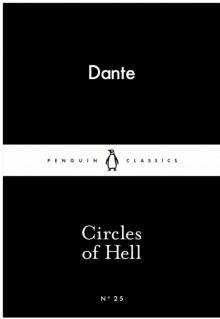 Circles of Hell
Circles of Hell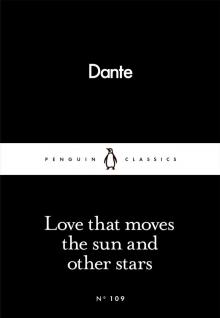 Love That Moves the Sun and Other Stars
Love That Moves the Sun and Other Stars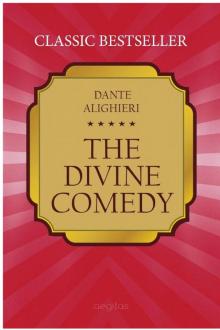 The Divine Comedy
The Divine Comedy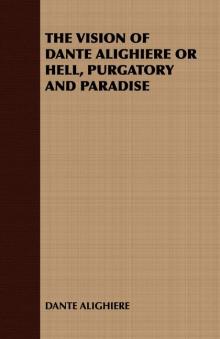 The Vision of Dante Alighiere or Hell, Purgatory and Paradise
The Vision of Dante Alighiere or Hell, Purgatory and Paradise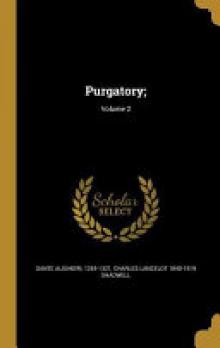 Purgatory
Purgatory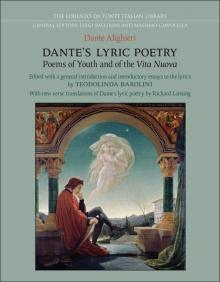 Dante's Lyric Poems (Italian Poetry in Translation)
Dante's Lyric Poems (Italian Poetry in Translation)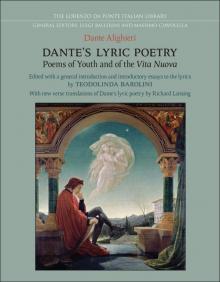 Dante's Lyric Poetry: Poems of Youth and of the 'Vita Nuova'
Dante's Lyric Poetry: Poems of Youth and of the 'Vita Nuova'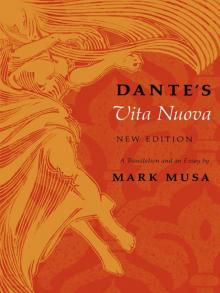 Dante’s Vita Nuova, New Edition: A Translation and an Essay
Dante’s Vita Nuova, New Edition: A Translation and an Essay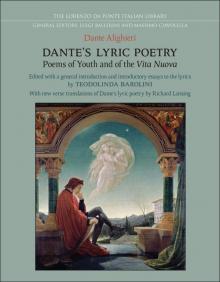 Dante's Lyric Poetry
Dante's Lyric Poetry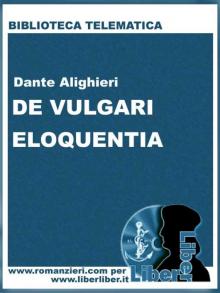 De vulgari eloquentia
De vulgari eloquentia The Inferno (Barnes & Noble Classics Series)
The Inferno (Barnes & Noble Classics Series)